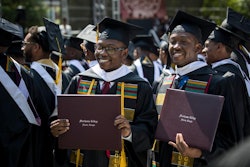The 1954 Supreme Court’s Brown v. Board decision sent a clear message to White educators, particularly southerners, that they were legally bound to admit Blacks to their public schools. Although history shows that it was many years before this mandate was followed by most southern states, it did lay the foundation for desegregation.
It also sparked a continuing national debate. Whites and Blacks alike viewed the Brown decision as a call for the eradication of all-Black institutions. The Whites consisted mostly of philanthropists who used the new legislation to justify their declining contributions to the Black schools. There were also Blacks who saw the existence of Black institutions as hypocritical in the wake of the Brown ruling. The question they raised was critical to Black schools in the South, where most HBCUs were located: How could Blacks justify the existence of historically Black schools when Whites are now constitutionally bound to admit Blacks to their schools? Concerned Blacks feared that the days of these much-needed institutions were numbered. Some were forced to close; still others, such as Atlanta and Clark universities, merged; but for the most part, Black colleges survived. The survival of Black institutions is, once again, being debated. This time, because of desegregation and changing enrollments, a new hysteria regarding the cultural and historical endurance of Black institutions has arisen.
Despite competition from predominantly White institutions (PWIs) for the brightest Black students, Black enrollment remains significant at HBCUs. About one-fifth of all college-going Blacks choose to attend one of the 103 HBCUs, and these institutions are responsible for more than a fifth of current bachelor’s degrees granted to Blacks. With such documented successes these schools are in no danger of ceasing to exist. However, the newest concern is that increases in White enrollments will cause HBCUs to lose their “cultural identity,” and their historical significance to the Black community.
Such fears must be put to rest. Whites have always attended Black schools. A few rural HBCUs, such as Bluefield State University (W.Va.) , Lincoln University (Mo.), Kentucky State University, and West Virginia State University have become PWIs, representing less than 5 percent of HBCUs. After the 1992 Supreme Court ruling in the Mississippi Fordice case mandated the Fifth district to either justify the existence of Black institutions or integrate them, some southern state legislatures began to require that public HBCUs increase White enrollments to 10 percent of their population in order to get state appropriations. Thus, in spite of having always welcomed Whites, and at a time in America’s history when affirmative action is being routinely contested in our courts as unfair to Whites because it gives preferences to minorities, many HBCUs face legislation that not only mandates a quota, but is, in essence, a form of blackmail. Yet Black institutions are not reaching their target White population easily. Why? The answers are as plain as Black and White: most Whites do not want to attend Black institutions because, excluding prejudice, and with the exception of poor rural Whites, most Whites have too many other choices. In addition, due to the inability of the HBCUs to “toot their own horns,” most Whites, and, unfortunately, a good number of Blacks, know nothing about these Black schools or their successes. As a result, even the premier HBCUs are seen as inferior by many Whites.
For the sake of argument, let’s say the day does come when most Black colleges have predominantly White populations. Will this change the “cultural identity” of these schools? To answer this question, I rely upon the words of noted sociologist, Charles Willie, an alumnus of two HBCUs, who in 1993, called for a 20 percent Whites integration of Black schools as a means of enriching the college experience for Whites, and, more importantly, as a way for Black institutions to use Whites as messengers to promote HBCU successes. Some might point to Joshua Packwood, Morehouse College’s first White valedictorian, as an example of this. Packwood sings the praises of being a “Morehouse man” in several newspaper interviews. Others might see this as more reason for apprehension. In response to the Black community’s concerns that increased White populations at HBCUs would mean the loss of Black “culture” Willie states:
… let me assure you with comparative data that such is not likely to happen. I
have served as a faculty member at Harvard University for nearly two decades
and have seen the minority student component of Harvard’s student body grow
from one-fifth to one-fourth to one-third. Despite the enlarged proportion of
African-Americans, Latinos, Native Americans and Asian Americans in the
first year college class, Harvard continues to be a predominantly White
institution with a WASP-ish orientation (Journal of Negro Education, 1994, 63:2, p. 159).
Willie’s words of wisdom are just as true today as they were 15 years ago. Blacks who fear the effects of larger White enrollments at HBCUs are selling these institutions short. The culture, the legacy and the rich traditions of our nation’s HBCUs will live on in spite of a threatening White presence.
Trish Williams is an Ed.D. candidate at the University of Pennsylvania, where
she also serves as Dean of the W.E.B. Du Bois College House.
Click here to post and read comments
© Copyright 2005 by DiverseEducation.com


















